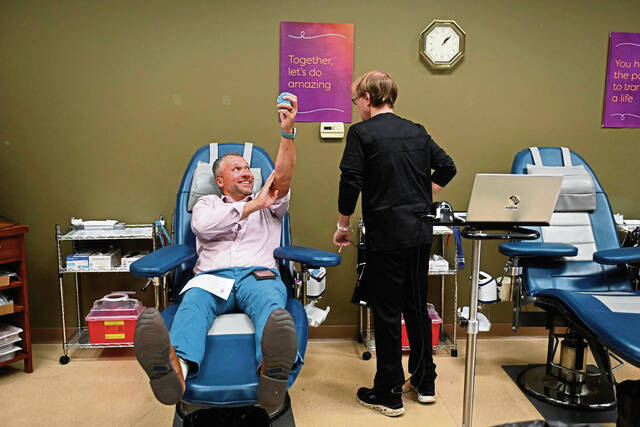Blood
Blood donations fall short by two-thirds in region, nonprofits says
Blood collection organizations say donations are down at least 25% — a trend they’ve been unable to break since the pandemic.
The American Red Cross announced a national blood shortage last week upon receiving 30,000 fewer donations than expected in August. That’s a 25% decrease from the 12,500 donations it needs to collect each day, said Nicole Roschella, regional communications manager.
Blood-collection nonprofit Vitalant is receiving about 200 donations a day — a third of its daily donation goal to support its Southwestern Pennsylvania health care partners, such as UPMC and Allegheny Health Network.
That’s about 100 donations fewer per day than Vitalant saw prior to the covid-19 pandemic, according to spokesperson Kristen Lane.
The nonprofit first began tracking a decrease in donations about 17 years ago, she said.
So far, Allegheny Health Network has not seen a significant “operational impact” from this decrease, said Trauma Medical Director Al Philp . But, if blood donations
remain at this level, a greater impact could be noticed in weeks, not months, he said.
The least crucial elective surgeries would be the first procedures put on pause if blood levels fall short, Philp said. More urgent elective surgeries, such as cancer and heart disease cases, would be delayed next.
In the worst-case scenario, hospitals may be forced to put a limit on the amount of blood they allot for emergency procedures, Philp said.
“We’ve never reached that point,” he said, “but I think every health system has thought about that and has a plan in place.”
“Those are the situations we definitely want to avoid,” Roschella said,” which can only be helped by people coming in to give blood to build back up the supply.”
Hospitals are in highest need of blood platelets, which have a short shelf life, and universal blood type O, said Amy DeCesare, blood bank system supervisor for Independence Health System’s Westmoreland area hospitals.
“We join the Red Cross in encouraging any eligible donors to give blood,” DeCesare said. “If anyone is not able to donate personally, we remind them that they can also help by recruiting others to donate blood.”
Independence Health’s Butler and Clarion area hospitals, which use about 40 units of blood per week, are “maintaining blood supply levels to ensure all patients’ needs are fulfilled,” spokesperson Robin Jennings said.
The Red Cross “provides about 40% of our nation’s blood and blood components,” according to its website. It provides blood to the Independence Health System,
Vitalant — formerly known as Central Blood Bank — runs 115 donation centers across the country, including 10 in Western Pennsylvania. It provides blood to about 900 hospitals.
If a region does not bring in enough local blood donations in a given time frame, Vitalant will first lean on its other regions to direct blood where it is most needed, Lane said.
“Hospitals will never sacrifice patient safety or patient care, and it’s Vitalant’s responsibility to find that blood to meet the needs of the hospitals we serve,” Lane said. “We would be very pleased if we could get the entire supply of blood donated by people here locally, but that is just not the case at this point.
“We’re making sure that we work with the other locations within our organization to get that blood.”
The Red Cross last announced a blood shortage in January 2022 because of a decrease in donations seen during the pandemic. Now, the decrease in summer donations and the impact of Hurricane Idalia are likely to blame, Roschella said.
It is common for the Red Cross to receive fewer donations during the summer months, Roschella said, because people tend to schedule vacations and stray from their typical schedule. Memorial Day, Labor Day and the July 4 holiday have a similar effect on donations.
Blood drives were canceled in Florida as a result of Hurricane Idalia, a Category 4 tropical storm at the end of August. Roschella said the trend is expected to continue with an active hurricane season ahead.
Vitalant has noticed a decrease in the number of people attending blood drives, Lane said.
Vitalant aims to hold five to seven blood drives a day. Colleges, high schools, churches, synagogues, businesses and sports teams like the Pittsburgh Pirates have hosted drives in the past.
Drives that attracted about 50 donors prior to the pandemic may draw about 20 to 25 people now, Lane said.
Some organizations no longer host blood drives, Lane said. That includes companies that have switched to remote work or have prohibited visitors because of tightened security standards.
The progression of medicine and generational changes may also be affecting blood donation levels, Philp said.
People used to view donating blood as a civic duty, he said, but surgeries often can be completed more quickly and with less invasion than in the past. Because of this, younger generations in particular may not know how often blood is needed in hospitals.
“You hope you’ll never need it, but if your kid crashes the car after prom, you’re sure going to want the blood bank to be full,” Philp said. “When you donate, the chance you have to help someone in your own community — someone in your church, your neighborhood, your kid’s school — that’s a gift that does not go to waste.”
Because blood has three usable components — platelets, plasma and red blood cells — one donation has triple the impact, Lane said.
“Each one of those components goes to a separate patient, so what’s amazing is, with one donation — one hour out of your day — you can save as many as three patients’ lives,” he said. “It’s such an amazing feeling to know that you’ve helped people right in your community.”
Quincey Reese is a Tribune-Review staff writer. You can contact Quincey by email at [email protected] or via Twitter .

